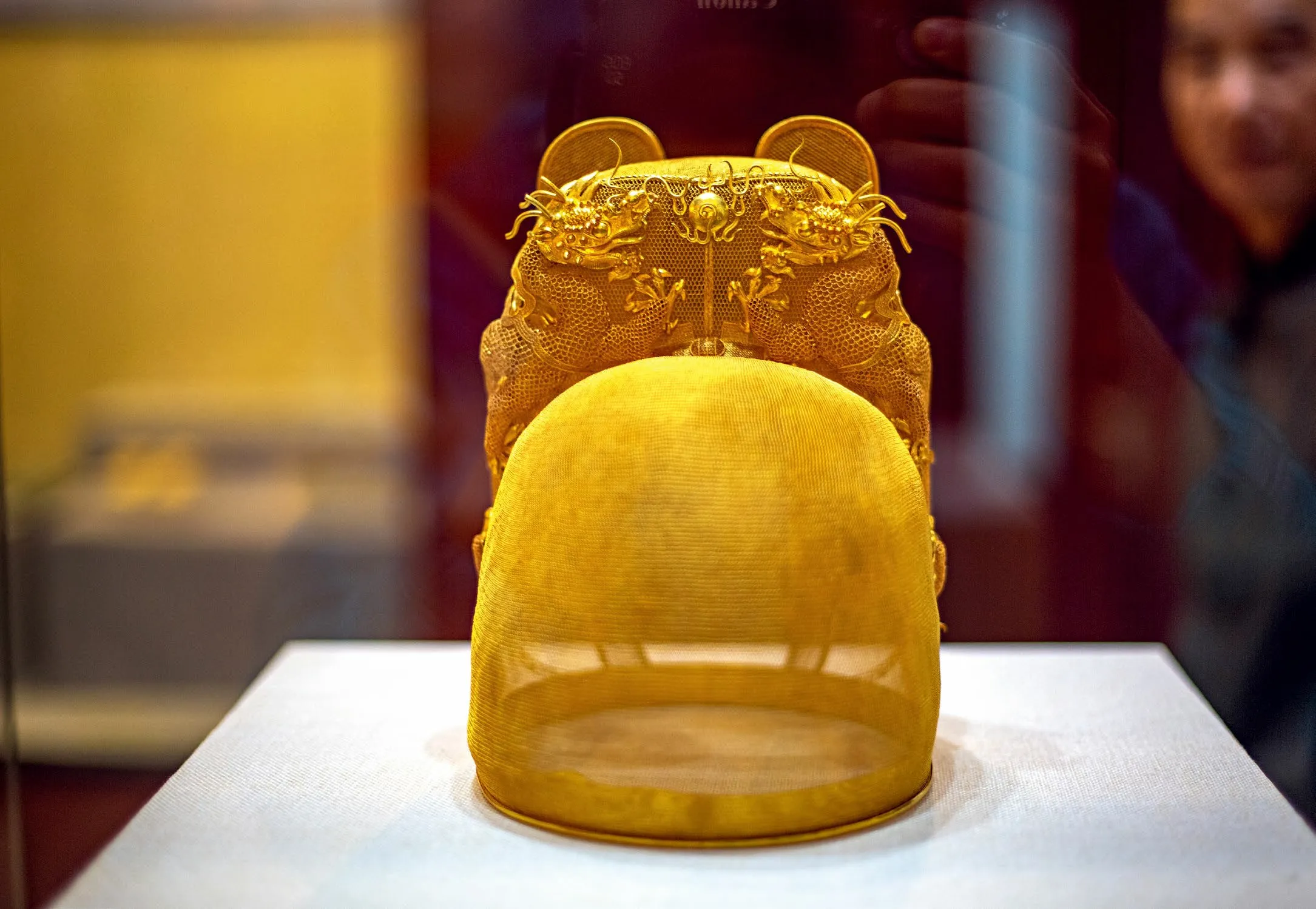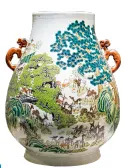Crafting a Saga
2022-06-23ByZhangYan
By Zhang Yan

The front of an excavated gold-wire diadem of Emperor Wanli (1563-1620) of the Ming Dynasty (1368-1644). (VCG)
Its long history and traditional culture have endowed China’s capital of Beijing with an abundance of intangible cultural heritage and an ensuing vast number of traditional techniques. According to Li Linlin, deputy director of Beijing Cultural Heritage Protection Center, the capital’s inheritance boasts three gleaming assets:a long history, huge diversity and wide popularity among the society’s highflyers and grassroots alike.
In recent years, the center has adopted various methods to preserve many different forms of cultural heritage, one such example being that for time-honored brands, it helps organize inheritor training. Academic and teaching resources in Beijing-based universities make it possible for these inheritors to take classes there, expanding their minds on brand marketing and upgrading their design philosophy. It also strengthens the recording of intangible cultural heritage through various publications starring national-level heritage representatives.
According to Li, the storage and recording of these cultural resources is a key part of protection efforts. They make full use of digital technology and other modern ways to document inheritors’ knowledge and practices, such as by collecting existing documents as well as logging oral accounts and shooting instructional videos.
For centuries, craftsmen have been working hard to preserve these cultural fortunes denoting typical symbols of Chinese civilization and culture, and passing them down to the next generations.
Insistence and Inheritance
The center hosted an event to promote its undertakings on February 3. For the occasion, Han Haijuan from a Beijing-based jewelry studio presented a real-size gold-wire diadem modeled on the one excavated from the Ding Mausoleum of Emperor Wanli (1563-1620) of the Ming Dynasty (1368-1644), wowing those in attendance. According to Han, its filigree inlaying consists of eight major processing procedures, each bearing its own unique features—all extremely difficult to create.
To Han, welding proves the trickiest among the eight processes:If the degree of heating is not meticulously managed, the whole thing will have to be discarded. “The key to carry on with this job is the spirit of persistence and the passion for this art. Throughout each and every procedure, craftsmen pour their own emotions into the creation, and thus every work bears an inimitable soul,” said Han.
The art of filigree inlay, also called “fine gold art,” combines two craft skills. One is filigree, which includes techniques like nipping, plaiting, jointing, piling, filling, and knitting, and uses gold or silver threads of different weights. The inlaying craft, complicated, graceful and majestic, was limited only to the imperial palace in ancient times. In recent years, as filigree inlaying works often appear in costume dramas, many young people have developed an interest in this art. Today, the Beijing Institute of Fashion Technology and Central Academy of Fine Arts even offer courses in the fine art. The center, too, has dispatched teams to communities and businesses to give lectures on filigree inlaying.
The key to carry on with this job is the spirit of persistence and the passion for this art.
Tangibly Tricky
Beijing decorative porcelain, another intangible cultural element, was originally a technique confined within imperial walls, but later made its way to the common people during the late Qing Dynasty (1644-1911). Take the bailu zun, a decorative vessel with 100 deer painted on the porcelain, as an example. Born in the 18th century during the reign of Emperor Qianlong (1736-1796), it was created by no less than 2,000 craftsmen, its visuals adjusted and refined more than 300 times over a period of 10 years. Every strand of deer hair on the wine vessel was painted on by craftsmen, one detailed stroke after another.

The back of an excavated gold-wire diadem of Emperor Wanli (1563-1620) of the Ming Dynasty (1368-1644). (VCG)

A bailu zun. (IC PHOTO)
“Decorative porcelain is a typical project of intangible cultural heritage protection. It requires craftsmen to not only inherit the techniques, but spend time learning about the relevant ancient culture. We are trying our best to present this art to the public by introducing it on campuses, in communities and online,” said Yang Xue, a fifthgeneration inheritor of the craft. “Sometimes, we invite laymen to come enamel the vessels in person. This type of Beijing ceramics has also made an appearance at international events like the Conference on the Dialogue of Asian Civilizations and the Belt and Road Forum for International Cooperation. Guests are thus able to experience what the art of decorative porcelain holds,” Yang continued.
“These knots may look cute, but they are hard to make,” said Li Wei, a heir of the intangible cultural heritage of knot-making. “Usually, people try to make solid ones, but my target is to make neat, symmetrical and flowing knots. They come in a wide variety, made of cotton, hemp, silk, nylon, and even gold and silver threads. They can be applied to ornaments, apparels, handbags, furniture, and so on, to make these things appear more attractive.”
Li first developed a strong interest in the art of knot-making when he was very young, but it wasn’t until he turned his hobby into a profession that Li began to fully grasp the meaning of the word “craftsmanship.” “It not only requires patience in the process of making knots, but more importantly, perseverance; the handwork takes up a lot of time and you often feel you don’t have enough (time). We must take the traditional techniques and hand them over to the next generation, all the while adding some of our own innovations.”
Like many other inheritors, Li Wei hopes that more people, particularly the younger generations, will join the effort to protect and pass on intangible cultural heritage. “I hope more people will connect with the big family of knot-crafting, and their interest will thrust them into further professional studies. And we hope that these artistic knots can become sewn into people’s daily lives.”
